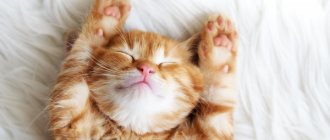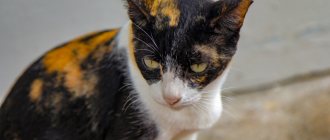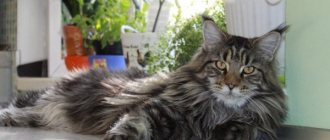When is a cat sedative used?
Let us highlight the main circumstances in which the use of sedatives is justified, and sometimes desirable:
- A change of scenery
Cats, unlike people, do not experience a passion for change, and a change of environment for most purrs is a direct path to stress. Moreover, this applies to both adult animals and kittens. In order for adaptation to new conditions to be painless, it is better not to take the medicine on the road, but to start giving your pet sedatives for cats in advance, because many of them have a cumulative effect and do not begin to “work” immediately, but as the main active substance accumulates in the body .
- Moving
A long journey, and especially a long journey on public transport, is stressful in a cube! Of course, there are exceptions and cats may not need sedatives during transportation, but in most cases, unusual smells, foreign surroundings, traffic shocks and other delights of a long journey drive the cat into panic, and this is the case when a tablet/drops can easily solve the problem.
- Anxieties, phobias
You invited guests, and the guests brought children? Murka, where is your sedative for cats? Did you accept? Kids, who wants to cuddle the cat? Well, of course, the cat doesn’t mind!
- Nervous disorders
Traditional obsessive-compulsive and mental disorders in cats include:
- obsessive self-licking, tearing out fur;
- hunting for non-existent prey, fixed gaze;
- overeating, sucking tissue (wool, for example);
- endless meowing;
- obsessive movements of the head, tail, unmotivated jumping;
- aggression towards oneself;
- aggression towards people.
Sedatives for cats will help with aggression, but they will not eliminate the cause of aggression or other behavioral problems! Sedative medications smooth out the above pathologies, but in the presence of nervous disorders, veterinarians recommend special comprehensive treatment regimens.
- Participation in exhibitions, grooming, visiting a veterinary clinic
Is your pet due for vaccination, a visit to a grooming salon for a haircut, or a trip to an exhibition? While taking a sedative, these events will be painless.
IMPORTANT! Before giving sedative drops for cats when going to the veterinary clinic, check if the doctor objects, because sometimes such drugs do not allow you to correctly assess the exact course of the disease.
- Anxiety due to sexual desire
Seasonal aggression, hypersexuality, incorrect attempts to become a leader of the pack against the background of sexual desire are symptoms for which the use of sedatives is justified. The use of a sedative during estrus reduces stress in the animal.
- Territory marking
Some calming pills for cats reduce this desire to leave autographs on all corners and suppress the hormonal explosion.
When to give your cat sedatives
Ideally, the owner himself should understand when his pet will be nervous. Still, transfers and trips are not planned in one minute. Before an important event that is nervous for a cat, it is advisable to visit a veterinarian and ask him what remedy will help the pet cope with the events. As a rule, the most stressful things for a cat are:
- Traveling in transport . Stress will be inevitable even for the calmest pets. It will be especially difficult for the cat if you have to travel on public transport, where dozens of new characters will chat loudly and look at the pet. For cats who are used to riding in the owner's car, any trip will be more bearable, but new people will still scare the pet.
- Change of home . It’s not only people who tear their old apartment or cozy yard away from their hearts. Cats also become attached to housing, and when moving to a new place, they are very worried and sad. They are unable to understand the reasons why the owner had to change such a dear, fully explored place to a foreign place, where everything is new. Some pets may even become sad, get sick, and refuse to eat or play. In case of a change of housing, experts recommend starting to give the cat sedatives several weeks in advance, since these drugs have accumulative properties and begin to fully act only after a while.
- Noisy parties at home , which are attended by a lot of guests, are also stressful for the cat. Some pets are real social phobes and cannot tolerate guests. The situation is especially bad if a bunch of children come home, who, of course, will first of all pay attention to the cat and want to play with him or take a photo. During particularly noisy events, sedatives for the cat will not be superfluous.
- Hormonal hurricane . At a certain period in their lives, cats and kittens follow the call of nature and want to find a mate. If this does not happen, the pet experiences physical and psychological unrest. In such situations, sedatives will come in handy.
- Different reasons . Sometimes a pet is nervous because of some illness or obsessive condition. Cats can react even to changes in weather and behave inappropriately.
- participation in the exhibition;
- visiting a veterinary clinic;
- vaccination;
- fear of strangers;
- haircut in a grooming salon.
You need to understand that any sedatives are medications that have both benefits and harm. They should be given to your cat only in extreme cases, when symptoms of nervousness are evident. If the house is full of guests, and the cat has expressed a desire to communicate and be curious, it is obvious that this prankster does not need a sedative.
How do sedatives work for cats?
All sedative medications for cats can be divided according to their principle of action.
Long-acting medications include homeopathic remedies, which, as a rule, consist mainly of the same set of herbs that reduce stress in cats. It is recommended to give homeopathic sedatives in advance, expecting that the peak of accumulation will occur at hour X. Homeopathy has a gentle effect on the cat’s nervous system.
Chemical preparations (in tablets, drops and injections) work more quickly, but their effect on the body is quite strong.
What does a cat that has taken a sedative look and behave like?
General calmness is a symptom that the sedative is working correctly on the cat. The cat behaves “as usual” - and this is a victory!
But be prepared for this scenario - you gave your pet a precisely measured dose of sedative, but the ocean of passions is still stormy. Sometimes cats bring themselves to such a state where a rare remedy can curb the raging nervous system. This is the case when it is easier to prevent an explosion, that is, start giving a sedative in advance and regularly.
What does a cat look like after taking too much sedative?
An overdose is expressed in the following symptoms - drowsiness, nausea, vomiting, gastrointestinal disorders, drop in blood pressure.
If any of these symptoms appear, the sedative should be stopped, the animal's stomach should be rinsed and enterosorbents should be given.
Contraindications
Contraindications are unique for each of the drugs, but if we summarize all the contraindications, then taking sedatives is undesirable (or should be extremely careful) if you have:
- hypersensitivity to the components of the drug;
- low blood pressure in an animal;
- pregnancy;
- lactation;
- diabetes;
- diseases of the genitourinary system;
- in some cases, manufacturers do not recommend giving their product to animals under one year of age.
Sedatives for kittens and pregnant cats
For kittens, when weaning from their mother and during the period of adaptation to new conditions, it is better to use collars, fumigators and sprays with pheromones that are safe for the growing body. But for pregnant cats, you should not select sedatives on your own. Mild homeopathic medicines may not have the desired effect, and chemical ones are contraindicated due to their toxicity. Xylazine, for example, can cause premature birth, so it is prohibited to take it in late pregnancy. You can calm your pet by arranging a warm nest for it in a secluded place, but you should consult a veterinarian about medications.
The kitten will get used to its new home faster if you spray the bed with a spray with pheromones - this smell will remind him of his mother, and the baby will feel safe
Types of sedatives, prices and reviews of them
All sedatives, as we mentioned above, are divided into homeopathic and chemical.
Homeopathic sedatives for cats
Herbal preparations such as motherwort, catnip, peony, and valerian do not, as a rule, contain nootropic substances.
The most popular homeopathic sedatives include:
Relax Plus (cost – 75 UAH /279 rubles)
According to the manufacturer, the Latvian company GIGI, this product “promotes relaxation, calms and stabilizes the nervous system in cats, and reduces stress.” Latvian pharmacists also promise an antispasmodic and cardiotonic effect from the use of Relax Plus. Another advantage of this sedative is that it works well against motion sickness and is good for long and difficult trips.
Katerina: “I needed pills that would help Gucci the cat get through the March days easier. It’s almost impossible to put a pill into my cat—it twists out, scratches, and then just spits it out. Cheating and crumbling into food is also not an option; in this case, he won’t even touch the food. I was advised to use Relax Plus at a veterinary pharmacy, explaining that the tablets have an attractive smell for cats. As for me, the medicine smelled like fresh grass and did not cause Gucci’s appetite. The tablets are collecting dust on the shelf, and I went to the veterinary pharmacy again(((“.
“Stop stress” (cost – 55 UAH /130 rubles)
This is a Russian drug with universal action. Unlike most homeopathic remedies, Stop-Stress already contains the nootropic substance phenibut. In a duet with herbs, phenibut has a sedative, tranquilizing, antioxidant and psychostimulating effect.
Arina Gam: “Our retired cat has never been outside in a decade, so when we planned to move to another city, I purchased a bottle of “Stop-Stress” in advance. I gave the medicine according to the instructions for a week, the cat tolerated the trip easily, I can recommend the medicine.”
Nastya Chernysh: “Stop stress is not a safe remedy! It almost killed my cat. We had to take a second cat into the house for foster care and our pet cat had a very hard time living in the neighborhood. I bought this drug and gave it exactly as written in the instructions. At night, terrible things began to happen to the cat - he rushed around the apartment, tried to hide, while his pupils were dilated to the limit, then convulsions began... The doctors saved our poor cat until the morning. They suggested that phenibut, which is part of the sedative, affected the central nervous system. Be careful!"
“Fitex” (cost – 58 UAH / 125 rubles)
The Russian manufacturer of this product emphasizes its exclusively natural composition. Indeed, extract of valerian officinalis, motherwort, hops and Baikal skullcap on glycerin and water is the optimal cocktail for especially delicate and impressionable cats. Available in the form of drops.
Larisa Igorevna: “I started looking for a sedative when my cats from the same litter decided that they were a wonderful couple. But they decided it too early, both were only 5 months old, so after scouring the Internet, I chose the drug “Fitex”. It works and runs very smoothly and I love that about it. The cat and kitty have calmed down and we are peacefully growing up to our sexually mature age.”
“Anti-stress” (cost – 65 UAH /150 rubles)
105 tablets of the master's happiness - this is exactly the standard packaging of this sedative. Its composition is very “tasty” - seaweed, motherwort, taurine, which is so beneficial for cats, vitamins C and B, brewer’s yeast, etc. not only help you cope with stress, but also increase the body’s defenses.
Natalya Petrova: “I heard the opinion that when castrating a cat, it is better to give him a sedative. I settled on “Antistress” precisely because of its natural composition. I can’t say that “Anti-stress” worked particularly well - the cat was sad after the operation, which is probably understandable. But the healing and recovery process itself went very quickly.”
“Feliway”, a behavior modulator for cats (cost – 830 UAH / 2200 rubles)
What is unusual is that Feliway is produced by French pharmacists in the form of a spray. Although not a drug, it nevertheless perfectly normalizes the emotional state of the animal. A special diffuser is included in the packaging of the drug, which should be plugged into an outlet. In this case, the active substance begins to evaporate and cover an area of 50-70 square meters. There is simply no chance for a cat to remain nervous and excitable!
Margot: “The main disadvantages of Feliway are its price and the fact that it is rarely found on sale. The rest is a set of advantages. We brought a kitten into the house, which began to behave inappropriately - it was afraid, rushed about, scratched and tore furniture to shreds. But I already had a similar experience and our family was ready - we immediately turned on “Feliway” and literally an hour later the kitten purred and went into our arms. The bottle lasts for a month. But I didn’t have to use it for so long, after a few days adaptation began and today the cat and I are best friends.”
Chemical sedatives for cats
We warn you right away that most chemical sedatives are heavy artillery. Choosing them based on reviews on the Internet and at random is not correct and even dangerous! Therefore, below we provide a list of the main drugs with brief characteristics of each, but the main thing for you when choosing such a sedative should be the opinion and review of the veterinarian.
So, the following have a sedative effect:
"Amitriptyline" (cost - 17 UAH / 56 rubles)
Some experts classify this drug as an antidepressant and admit that it copes well with problems such as chronic anxiety in cats and cats marking their homes.
“Buspirone” (cost – 165 UAH / 680 rubles)
Prescribed mainly when the animal has phobias. It is important to know that Buspirone produces its maximum effect only a month after the start of use.
“Diazepam (Valium)” (cost – 19 UAH / 60 rubles)
This drug was developed primarily for humans, but in veterinary medicine it is used as a short-term sedative and to stimulate the animal's appetite.
“Xylazine” (cost – 68 UAH / 460 rubles)
It is interesting for pets because it gives an instant calming effect that lasts from 1 to 2 hours.
“Vetranquil 1% solution” (cost – 185 UAH /740 rubles)
This drug has many pharmacological properties, but in the context of a sedative, it is interesting to us because it helps a cat to endure a trip easier and has antiemetic properties. When administered intramuscularly, Vetranquil begins to act after half an hour and works for at least an hour; when administered intravenously, the effect is noticeable within 5-10 minutes.
IMPORTANT! Do not use the above remedies without a doctor’s prescription!
There is another type of sedative that is sold in an unexpected format - in the form of a collar!
These cat collars are impregnated with synthetic pheromones that imitate the pheromones of a mother cat. It is recommended to put them on babies so that the kitten’s insecurities, fears, and worries disappear.
Sleeping pills for cats
The use of sleeping pills is most often not associated with sexual activity, phobias and fears. Optimal sleeping pill for cats for transporting the animal. Before you board a plane, close a train compartment, or simply take your seat by the window of an intercity bus, give your cat a sleeping pill and your pet will be protected from unnecessary worries.
Types of sleeping pills
Sleeping pills for cats are divided according to the duration of exposure:
- a short;
- average;
- long lasting.
Depending on the time of the trip, you yourself can regulate the duration of your cat’s sleep.
Short-acting sleeping pills
Most often, these products are used to make cats fall asleep easier. Since this group of drugs belongs to psychotropic drugs, they are often not available for free sale, so you will not see their prices below.
Of the most popular sleeping pills, we highlight:
- "Etaminal-sodium"
The drug is low-toxic and can also work as a sedative, but it is important to keep in mind that repeated use can lead to addiction.
- "Barbamil"
The hypnotic effect occurs 50 minutes-1 hour after administration and lasts 6-8 hours.
Intermediate-acting hypnotics
- "Barbital sodium"
Falling asleep begins an hour and a half after administration of the drug. Complete removal of the drug from the body occurs 10 hours after administration.
- "Noxiron"
If your pet is very agitated, it will not help your pet, but this medicine combines well with other sedatives. The cat falls asleep 20 minutes after taking the sleeping pill.
- "Chloral hydrate"
The drug has a large list of contraindications and warnings, so its use should be strictly under the supervision of a doctor.
Please note that all sleeping pills must be prescribed to your animal by a veterinarian, taking into account the characteristics of its physiology and health! After your pussy has been injected with a sleeping pill and you are finally settled in the transport, make sure that the animal lies correctly throughout the journey - the cat's neck should be extended. Provide your pet with access to air and a warm blanket.
So, if your cat has begun to professionally play on your nerves, but does not always hit the notes, it’s time to think about your mental health and buy a sedative or sleeping pill... for the cat.
Take care of your and your cat's nerves!
Drugs for regulating sexual desire and behavior
Question: how to prevent a cat from asking for a cat, can be quite successfully solved by using special means. Anti-estrus medications for cats are available in the form of drops, tablets, suspensions or injections. Their variety is quite large; you can choose among products of different price categories and varying degrees of impact on the animal’s body. Depending on the regimen of use, these drugs can stop estrus or delay it.
When deciding what to give to a cat without the cat asking, you should pay attention to specially designed drops. This form of release makes them easier for animals to consume, which is important. In addition to its main function, drops for cats from walking often have a calming effect. After all, the persistent, exhausting meow of an animal indicates nervousness, fear and uncertainty.
Each heat that does not end with a date with a cat undermines the cat’s health and has a detrimental effect on the immune system and nervous system.
Another solution to the problem is an injection for the cat so that the cat does not ask for it. Hormone injection prevents the occurrence of estrus for about six months. Injections can be given only before the onset of estrus; you must strictly follow the application regimen, which includes several sessions. The regimen must be developed individually by a veterinarian, who also makes the first injection. Cannot be used on cats over five years of age or with health problems. But even in absolutely healthy animals the risk of complications is high. So the benefits of using this method, according to many veterinarians, do not exceed the risk of diseases and side effects.
In general, many drugs are not aimed at stopping estrus, but at correcting the pet’s behavior during this period. They have a calming effect and are generally gentler on the body. And the means to directly prevent physiological changes are based on the action of hormones. The degree of their safety depends on the composition and concentration of active substances, as well as on the health status and individual characteristics of a particular animal. But there are simply no drugs without possible side effects. Among the most common: hormonal imbalance, the occurrence of tumors, diabetes. The use of special tablets and drops is justified as a one-time action, in combination with other means, and not on an ongoing basis.
In a situation where a cat asks a cat, it is, of course, up to its owners to decide what to do. But the choice of special medications to solve the problem should be approached very responsibly, and also monitor the cat’s condition while taking the medications. It is possible that a method such as sterilization is more suitable for the animal.
How to identify the cause of anger in a cat
Don't forget that a cat is not a dog, which is one hundred percent a pet. Cats still have wild instincts that tell them that anything can be dangerous, even humans. So, cats can show fear and begin to get angry in such situations:
- the child pulled the cat by the tail and the animal, in turn, begins to associate it with an object that can cause pain, and therefore shows unfriendliness towards it;
- a cat that is poorly adapted to the home will be afraid of everything around it, which, accordingly, will be expressed in manifestations of aggression.
To understand when to expect your cat to act aggressively, pay attention to body language. Some gestures directly indicate that your cat is about to attack either you or your children and relatives. Be especially careful when you see the following:
- the fur stood on end;
- pupils dilated;
- the cat is looking directly at you or a potential victim;
- or avoids eye contact;
- mustache pressed;
- the cat's ears are pressed to the head;
- the animal's posture is crooked;
- the cat growls, hisses, and begins to grin.
Every time your cat shows aggression, think about the reason for this behavior in the current situation. Perhaps he is frightened either by your actions, or by the presence of strangers in the house who seemed suspicious to him and the animal believes that they can harm him or you.
How to calm a cat
You can calm a cat that is actively aggressive towards you in the following ways so that it does not cause you harm:
- put on protective clothing and take the animal in your arms, quickly wrap it in a blanket;
- Always have a water spray with you so that in case of aggressive behavior you can spray a little water in the direction of the animal. This way you will protect yourself from possible consequences;
- Do not tease or provoke the animal if you see impending aggression or after the first attack attempt.
Also, to curb the harsh behavior of the animal, the following actions should be taken:
- step away from the cat, you may need to leave the room for at least 10 minutes so that he “burns out”;
- if the cause of aggression is another cat or animal, then they should be isolated from each other for a while and introduced gradually;
- sit and do not look into the cat's eyes during the period of irritation, this will only increase its fear. You can lie down on the floor. This will make you seem shorter to the cat and it will calm her down;
- do not pay attention to the cat for a while so that he understands that you do not pose any threat to him;
- Make hiding places for your cat - sometimes staying in a safe shelter for a while helps calm the animal's negativity. If the cat is scared and has nowhere to run, the aggression will only intensify;
- approach the cat slowly and carefully, avoiding touching;
- or let him approach you himself so that the cat can be convinced that you are open to communication and do not want to hurt him. Let him sniff you, rub your head, so the animal will quickly understand that you are not as scary as he thinks;
- feed the cat or give it water;
- do not resort to punishment, otherwise attacks of aggression will be more frequent.
If the cause of aggression is pain
In some cases, pain is the cause of cat behavior. So, if before this your pet was affectionate and friendly, and then suddenly became aggressive, this may indicate that he is sick with something. To identify this, take your cat to the vet.
Common pain syndromes that provoke anger are:
- tooth pain;
- heat;
- inflammation;
- wounds;
- injuries;
- stretching;
- ear problems;
- problems with the digestive system.
If the doctor concludes that the cat has no health problems, then you can calm the cat using a sedative if other means do not help.
Sometimes cats show aggression towards something specific: people or objects. In such cases, you need to gradually accustom the animal to this and make it clear in every possible way that neither your friends nor children's dolls pose a danger to it. Gradually increase your cat's contact with this person or object, but do not do it suddenly.
Different cats have different degrees of socialization, so for some, a few days will be enough to adapt to a certain environment, while for others, even a year will not be enough.
When to use sedatives
A trip to the veterinarian, moving, visiting a groomer or exhibition, or even a change of owner - all these factors carry a huge burden on the cat’s psyche. Taking sedatives will be a great help to help your cat cope with stress more easily. Of course, there are such “iron” purrs that they don’t care about anything. But sometimes, reluctance to participate in any “adventures” can lead to a bloody massacre between the cat and its owner. That’s when you need to resort to various means of calming down.
Video: causes of stress in a cat
Helpful Tips and Warnings
Frequent aggression and anger in cats can be provoked by various reasons, which you cannot guess right away. Here are some tips and recommendations on this topic that may help you unravel the reason for your pet’s inappropriate behavior:
- sometimes aggression decreases after castration or sterilization of animals. If you do not plan to breed them in the future, think about it;
- if your cat reacts inappropriately to a neighbor’s cat or dog, agree with your neighbors so that their walk times do not coincide;
- anger and a feeling of fear overcome the cat when changing furniture, rearranging or moving;
- if you left and left the cat in the care of someone, then most likely its first reaction to your appearance will be aggression;
- Sometimes cats that are too well-fed show dissatisfaction because they cannot get rid of fleas. Everything can be resolved by visiting the veterinarian;
- To stop two cats in the house from quarreling, set up places for feeding them in different places in the room;
- Most cats are not enthusiastic about the need to go to the same litter box with another cat. They can be trained to go to the same litter tray, but it will be much easier to purchase one for each.
So, we understood one thing: you can’t respond to a cat’s aggression with aggression, everything needs to be resolved peacefully, let the animal understand that no one wants to offend him and everyone is welcome in this house. If he understands this, then he will forever change the attitude towards you and your guests who were afraid to come to you because of the evil cat.
- Vladimir Petrovich Petrenko
Useful materials:
- Cutaneous horn General description of the disease Cutaneous horn on the forehead or face (ICD 10 code - L57.0) -...
- Cloudy eye in a cat Common causes of cloudy eyes in a cat The most common causes of cloudy eyes are glaucoma, cataracts or keratitis.…
- Itching and odorless discharge Main causesBefore considering the factors that provoke the appearance of discharge that has a sour odor, it is necessary to immediately note...
- Normal temperature in animals Normal temperature in different types of animals Veterinary services Day hospital for animals Veterinary certificates Vaccination…
Alternative methods and recommendations
If the use of drugs or sterilization is undesirable, then you can turn to auxiliary measures that, if they do not solve the problem completely, will have a beneficial effect on the situation. When a cat goes on a spree, what to do at home is a pressing question. Several methods of influencing your pet are very popular.
Isolation from other animals is a completely justified measure, because the cat is already in an irritated, restless state, there is no point in giving it the opportunity to conflict with other cats and dogs.
And for smaller pets (hamsters, parrots, etc.) it can be dangerous. The place for isolation can be a bathroom or pantry. Naturally, you shouldn’t leave your pet there for a long time and you need to leave her drinking water and food.
If the question is very acute - the cat wants a cat, what to do? folk remedies are unlikely to help, then it is worth solving the problem radically. But if everything is not critical, then you can use ordinary natural sedatives, such as valerian extract. Naturally, the dose should be used much less than for humans.
When a cat is walking, nature itself can tell you how to calm it down at home. Everyone knows how much most felines dislike water. Accordingly, a cool shower is quite suitable for distracting and switching the furry screamer’s attention from personal problems to an external stimulus.
Naturally, this method should not be abused. Do not use cold water or leave the cat in a draft. Such a remedy will help both calm the cat when he wants a cat, and temporarily calm a cat that requires the cat’s attention. And after bathing, the animal will inevitably start cleaning itself up. While it licks its fur, the owners will be able to enjoy the silence.
When a cat goes on a spree, how to calm it down with folk remedies will tell you information about the rhythm of life of these creatures. Most animals are quite active and mobile. And even more so during heat. This means you need to play with the animal longer and more actively, provoke it to jump and climb.
In addition to the above, the answer to the question: how to satisfy a cat without a cat lies in feeding in small portions and attention from the owners. Feeling the care and presence of significant people, the pet will go through a difficult period more easily. Whatever way you choose to resolve the issue, you should not deprive your pet of the attention and good attitude of the owners. After all, this will also affect her mood and well-being.











